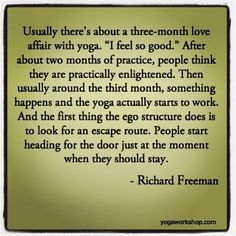
I’ve been posting some new classes and after rereading I thought to myself how does anyone really now what I’m talking about? I keep saying Mysore like everyone has this clear understanding. I use the word to describe something, a style of practice and if you practice in this method you understand what goes on in the Mysore room. One way to learn about it is to observe a session or class however the best way is to participate.
The Mysore Room is the Yoga Room and the *Shala is the Yoga Studio. Mysore is a city from which the practice originated and also where yogis in the Ashtanga method go to practice with their teacher. It’s a pilgrimage to the source. A Mysore session is where you get to do a self paced practice. That’s after you learn the sequence in the Mysore room under the guidance of your teacher. Your teacher also gives out the new poses and will let you know when it is time to add on to your practice. This applies to all levels of practitioners. There are hands on adjustments, verbal cues and lots of learning. New sensations, sweat and sometimes the mind is on overload. Your practice is your own and you are instructed in the asana (poses). The count sounds funny and instructions are brief. Sanskrit is used for the names of the poses mostly. For a first timer there are a lot of new things happening. First timers get instructed, then they get to be independent, but they are not sure that they want to be. The mind is more active for someone new to the mat. Students are instructed to breathe, to let the thoughts go, come back to the breath some more and to come back to doing the vinyasa. The vinyasa is the coordinated movement with the breath. Last week someone asked me what I practiced and I said, “Ashtanga Yoga”. They remarked, “Oh is that the one with the breathing?” I was pleased and replied, “yes, yes, it is.” and continued to explain that she had given it a perfect description.
The Mysore room is also a place where the teacher can teach you in a semi private way. The teachings are built off where you left off the last time you practiced at the Shala. Many times we get in our own way and we opt out. We leave too early, we try to do it on our own. We don’t trust that this method will work or that we will ever learn what to do. That it’s too hard. Yoga is not easy however in the Mysore method you only are instructed to do what you can do. There is support of the teacher, support of fellow practitioners and a shared energy that helps on the journey. Anyone can practice this Mysore method of Ashtanga Yoga . . . you just have to want to do it.
*Shala is a Sanskrit word meaning, “home, abode”. A Yoga Shala is a ‘place of yoga’. It is a gathering place for students of Traditional Yoga to practice, share, experience and grow.

